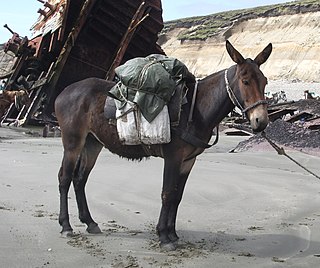
A biome is a community of plants and animals that have common characteristics for the environment they exist in. They can be found over a range of continents. Biomes are distinct biological communities that have formed in response to a shared physical climate. "Biome" is a broader term than "habitat"; any biome can comprise a variety of habitats.

The Cucurbitales are an order of flowering plants, included in the rosid group of dicotyledons. This order mostly belongs to tropical areas, with limited presence in subtropic and temperate regions. The order includes shrubs and trees, together with many herbs and climbers. One major characteristic of the Cucurbitales is the presence of unisexual flowers, mostly pentacyclic, with thick pointed petals. The pollination is usually performed by insects, but wind pollination is also present.

In geography, the temperate or tepid climates of Earth occur in the middle latitudes, which span between the tropics and the polar regions of Earth. These zones generally have wider temperature ranges throughout the year and more distinct seasonal changes compared to tropical climates, where such variations are often small. They typically feature four distinct seasons, Summer the warmest, Autumn the transitioning season to Winter, the colder season, and Spring the transitioning season from winter back into summer. On the northern hemisphere the year starts with winter, transitions in the first halfyear through spring into summer which is in mid-year, then at the second halfyear through autumn into winter at year-end. On the southern hemisphere seasons are swapped with summer in between years and winter in mid-year.
The Global 200 is the list of ecoregions identified by WWF, the global conservation organization, as priorities for conservation. According to WWF, an ecoregion is defined as a "relatively large unit of land or water containing a characteristic set of natural communities that share a large majority of their species dynamics, and environmental conditions". So, for example, based on their levels of endemism, Madagascar gets multiple listings, ancient Lake Baikal gets one, and the North American Great Lakes get none.
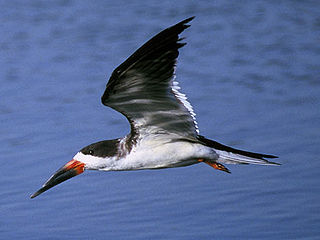
The skimmers, forming the genus Rynchops, are tern-like birds in the family Laridae. The genus comprises three species found in South Asia, Africa, and the Americas. They were formerly known as the scissorbills.

The Typhlopidae are a family of blind snakes. They are found mostly in the tropical regions of Africa, Asia, the Americas, and all mainland Australia and various islands. The rostral scale overhangs the mouth to form a shovel-like burrowing structure. They live underground in burrows, and since they have no use for vision, their eyes are mostly vestigial. They have light-detecting black eye spots, and teeth occur in the upper jaw. The tail ends with a horn-like scale. Most of these species are oviparous. Currently, 18 genera are recognized containing over 200 species.
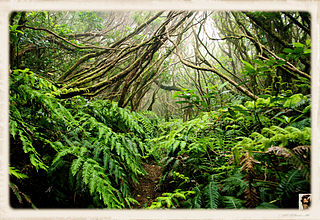
Laurel forest, also called laurisilva or laurissilva, is a type of subtropical forest found in areas with high humidity and relatively stable, mild temperatures. The forest is characterized by broadleaf tree species with evergreen, glossy and elongated leaves, known as "laurophyll" or "lauroid". Plants from the laurel family (Lauraceae) may or may not be present, depending on the location.

Ocypode is a genus of ghost crabs found in the sandy shores of tropical and subtropical regions throughout the world. They have a box-like body, thick and elongated eyestalks, and one claw is larger than the other in both males and females. They inhabit deep burrows in the intertidal zone. They are primarily nocturnal, and are generalist scavengers and predators of small animals. The genus contains 21 species.

Didemnum is a genus of colonial tunicates in the family Didemnidae. It is the most speciose genus in the didemnid family. Species in this genus often have small calcareous spicules embedded in the tunic and form irregular or lobed colonies. Some Didemnum species, including Didemnum vexillum and Didemnum perlucidem are considered invasive species. In early 2006, Didemnum vexillum was found covering a 230 km2 area of cobble habitat in Georges Bank off the coast of New England, and is classified as an invasive species of greatest concern in coastal areas throughout Europe, New Zealand, and North America. Didemnum sp. invasions have also been recorded in Canada, the Mediterranean, and the Netherlands.
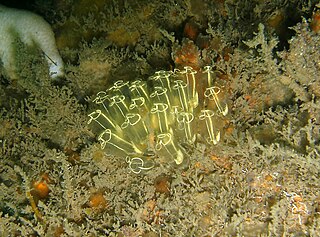
Clavelina lepadiformis, common name the light-bulb sea squirt, is a colonial sea squirt native to the NE Atlantic Ocean.

Pyura praeputialis is an intertidal and shallow water species of tunicate. It is one of three species of "cunjevoi" in Australasia. It is the first reported species of marine organism to create a "foam-nest" for its larvae.

Pontohedyle is a genus of sea slugs, acochlidians, shell-less marine gastropod mollusks in the family Microhedylidae. Sea slugs in this genus are highly simplified and uniform.
Pyura pachydermatina is a sea tulip, a solitary species of tunicate in the suborder Stolidobranchia. It is native to shallow waters around New Zealand.
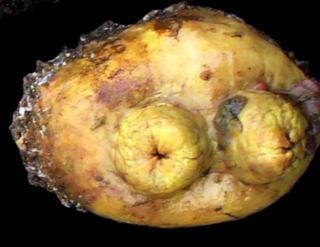
Pyura dalbyi is a species of large, solitary ascidians, or sea squirts.
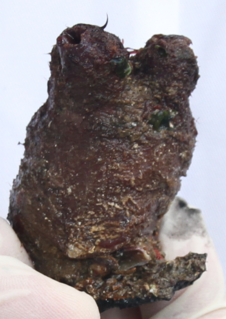
Pyura doppelgangera is a sessile ascidian, or sea squirt, that lives in coastal waters of Australasia attached to rocks or artificial structures.

Coscinasterias muricata is a species of starfish in the family Asteriidae. It is a large 11-armed starfish and occurs in shallow waters in the temperate western Indo-Pacific region.
Pyura haustor is a species of sessile ascidian, or sea squirt, that lives in coastal waters in the northeastern Pacific Ocean, attached to rocks or artificial structures. Common names for this species include the wrinkled seapump, the wrinkled sea squirt and the warty tunicate.







